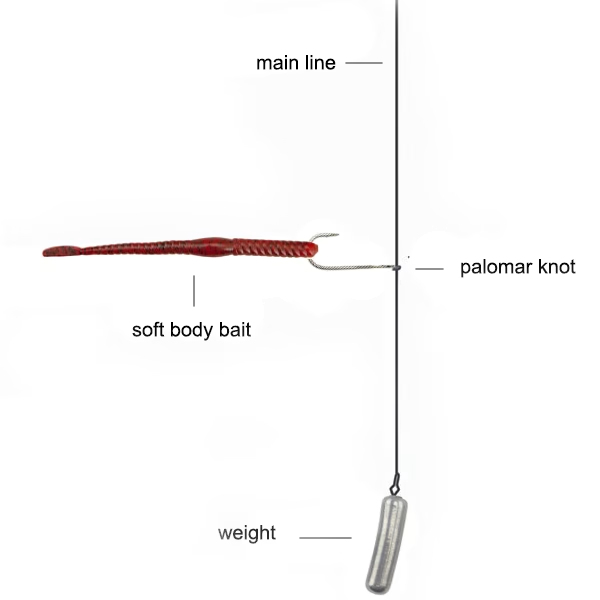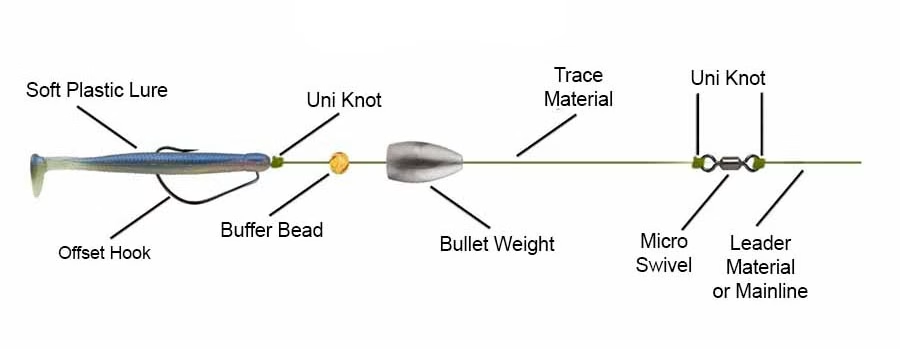Zander, a fish from the perch family is often called “the river baron” in Eastern Europe. Many anglers here spend their whole life in a wit and patience battle with this elusive predator habituating in deep rivers such as Drava and Danube. Every angler has an approach and lure presentation he swears is the best. In the following article, we’ll cover the best zander fishing rigs that proved to be ideal time and time again, in various conditions and periods of the year.
Top 3 Zander Fishing Rigs For Spin Fishing Method
Before we start, it’s important to note that all of the zander fishing rigs we’ll go through are for lure fishing. Live bait fish is not supposed to be used with these rigs. Fishing on a river with livebaits is a completely different method of fishing and it’s something we’ll cover in one of the future articles.
The Carolina Rig For Zander Fishing
The Carolina rig is one of the most versatile and effective zander fishing rigs, particularly in areas with varying depths and underwater structures. This rig consists of a sliding weight positioned above a swivel, allowing the bait to move freely along the line while keeping it off the bottom. This presentation mimics the natural movement of prey, enticing the zander to strike.
Creating a Carolina rig is simple. Follow these five steps:
- Gather Your Materials: You will need a braid mainline (usually 15-20 lb test), a barrel swivel, a weight (1/4 to 1 oz), a single hook (size 1 to 4), and your choice of lure
- Attach the Weight: Thread the mainline through the casting weight. You can use a bullet sinker or a similar weight. The weight allows your bait to sink and provides a good feel for bites.
- Add a Barrel Swivel: After the weight, tie a barrel swivel on the end of your mainline using a secure knot (like the improved clinch knot). The swivel prevents the line from twisting and helps with presentation.
- Create the Leader Line: Cut a length of monofilament or fluorocarbon leader (about 2 to 4 feet). Tie one end of the leader to the other end of the barrel swivel using a secure knot.
- Attach the Hook and Bait: Tie your hook to the end of the leader line. Use a single hook through the head of the baitfish, ensuring it’s secure. Now, you’re ready to cast.

Remember, if you plan to utilize this rig for pike fishing, consider using a steel leader to prevent line breakage due to the sharp teeth pikes have. Speaking of this fish, we already covered the most common lures for pike so check it out and make the best choice!
The Drop Shot Rig For Zander Fishing
A drop shot is among the most favored zander fishing rigs. It consists of a hook tied to the end of the line, with a weight attached to a short leader or directly below the hook. The hook is typically presented with a small, dead fish or soft plastic lure. The weight allows the angler to maintain control over the depth while keeping the bait off the bottom, enticing the zander. This rig is effective in snaggy areas and weedy conditions, allowing for precise presentation, and can be adjusted in depth to match fish activity levels.
To create a rig for the drop shot style of fishing, start with a mainline of your chosen fishing line, ideally a fluorocarbon for sensitivity and invisibility underwater. Then follow these five steps:
- Tie the Hook: Use a Palomar knot to attach a drop shot hook to the mainline. To do this, double the line and pass it through the eye of the hook, then tie an overhand knot around the standing line. Pass the hook through the loop created, and pull tight.
- Set the Drop Shot Depth: Determine the desired depth for your bait by measuring from the hook to the weight. Generally, this can be anywhere from 12 to 24 inches, depending on where the fish are feeding.
- Attach the Weight: Once the hook is secured, tie a drop shot weight to the end of the main line. A common choice is a bell-shaped or cylindrical weight that allows for easy bottom contact without snagging.
- Adjust for Conditions: If fishing in faster water or varying depths, ensure the weight is heavy enough to maintain contact with the bottom while still allowing the bait to drift naturally.
- Choose Your Bait: Attach your preferred soft plastic bait to the hook, ensuring it is rigged in a way that allows for free movement.

Your drop shot rig is now ready to effectively present baits at various depths while minimizing fluctuation in resistance.
The Texas Rig For Zander Fishing
The Texas rig is an effective technique, particularly in deeper water where zander often lurks. This rig consists of a weighted hook that allows for a weedless presentation, making it ideal for navigating submerged structures. Using soft plastic baits, anglers can mimic the movement of natural prey, enticing zander to strike. The rig’s design ensures the hook is positioned to ensure a solid hookset when your dream fish bites.
Setting up a Texas rig is straightforward. Just follow these five steps:
- Materials: You’ll need a soft plastic bait (like a worm or a creature bait), a Texas rig hook (preferably a size 4 hook, but this depends on the bait size), a weight (usually a bullet sinker), and a leader line, preferably fluorocarbon if the pike is not a concern.
- Weight Attaching: Slide the bullet sinker onto your main line. The pointed end should face your hook. This allows the bait to sit just above the bottom, making it more appealing to zander. Especially in shallow water where Zander sticks to the river bed.
- Rigging the Hook: Insert the hook point into the top of the bait, and push it through until the hook is embedded. This keeps the bait weedless and allows it to move freely even in the most weedy conditions.
- Positioning the Hook: Stick the hook out about one-third of the way down the bait’s body and then rotate it to insert it back into the bait, creating a straight line from the hook to the tip. This ensures the hook sets easily when a fish bites.
- Casting: Cast your rig into areas with structure or where zander are known to feed. Use a slow, steady retrieve, allowing the bait to bounce off the bottom to mimic wounded coarse fish.

Tips For Effective Use of These Rigs
When it comes to fishing for zander, utilizing the right rig is only part of the equation. Follow these tips to maximize your success.
1. Leverage Zander’s Night Vision
Zander have exceptional vision at night, allowing them to hunt effectively in low-light conditions. For this reason, consider night fishing if you aim for a more significant catch. To be precise, fishing during the twilight hours is ideal. That’s when zander is more active and likely to feed.
2. Choose the Right Color Lures
Color selection plays a vital role in attracting zander. Typically, natural colors such as brown, black, or green-gold colour, work exceptionally well, but experimenting with brighter lures can sometimes yield excellent results under specific conditions. If you’re fishing in clear water, opt for more subtle, realistic colors that mimic the natural prey of zander. On the other hand, in low light, murky water, and dirtiest conditions, brighter and more vibrant colors may be more visible and help you catch their attention. One example is the fire tiger pattern.
3. Fish with a Partner for Communication and Safety
While zander fishing can be a fantastic solo activity, having a fishing partner can enhance your experience. Working together allows for better communication regarding the activity level of the fish. You can compare results, save a bit of time by experimenting with different rigs or lures simultaneously, and adapt strategies based on each other’s findings. Moreover, fishing in pairs increases safety on the water, ensuring that someone is always nearby in case of accidents or unforeseen events, especially when fishing in remote areas at night.
4. Adapt Your Retrieve Technique
Lastly, don’t underestimate the impact of your retrieval technique. Baits that mimic injured prey attract zander. Use a slow, erratic retrieve to emulate a wounded freshwater fish, especially with the Texas rig. Vary your speed and make deliberate pauses to allow the bait to sink and settle, as zander often strikes when the bait appears vulnerable. Pay attention to the sensitivity of your rod, as zander bites can be subtle; being alert can mean the difference between a catch and a missed opportunity.
Conclusion
In summary, while there are various techniques for targeting zander, such as float fishing and jig fishing, the three zander fishing rigs we’ve discussed stand out as the most effective. We hope that you are now capable of setting them up. Good luck in utilizing them and we hope you’ll catch plenty of fish. Tight lines!
